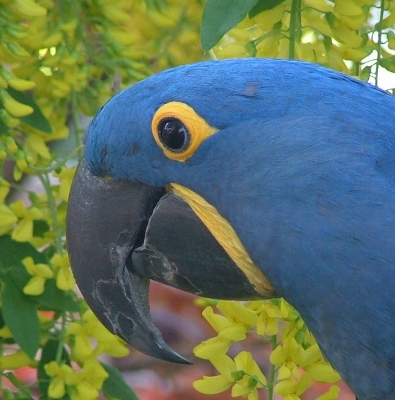
The hyacinth macaw is flying out of the spotlight as our Animal of the Month for July. We hope you’re following us on Twitter @ExoticPetVets and enjoyed our tweets throughout the month on these big and beautiful (and endangered!) birds. If you missed any of our tweets, here is a summary. Did you know?:
- The Hyacinth macaw (Anodorhynchus hyacinthinus) is the longest species of flying parrots, measuring 100 cms (3.3 feet).
- The Hyacinth macaw’s bill doesn’t have the tooth-like ridges seen in other macaw species.
- The no-ridge beak is reflected in the Hyacinth macaw’s scientific name: Anodorhynchus means “bill without teeth” in Latin.
- The Hyacinth macaw is a distinctive parrot with cobalt blue feathers and a yellow patch around the eyes and beak.
- Hyacinth macaws are sometimes confused with the Lear’s macaw, which is smaller and has a greenish tinge to the plumage.
- The Hyacinth macaw was first described in 1790 by British ornithologist John Latham.
- The Hyacinth macaw is native to eastern and central South America, mainly Brazil, Paraguay and Bolivia.
- Hyacinth macaws are endangered because of the pet bird trade and habitat loss.
- Hyacinth macaws are high maintenance birds and may prove to be unsuitable pets for most families.
- Hyacinth macaws need much attention and affection and some will bond with one person but behave aggressively with others.
- Hyacinth macaws have the ability to mimic human speech, but they are not as well known for this as African Grey parrots.
- Hyacinth macaws can be loud birds as they tend to meet the noise level of their environment. Noisy house = noisy macaw.
- Hyacinth macaws are intelligent and playful birds who need enrichment to prevent boredom.
- Hyacinth macaws have large beaks and they love to chew, which means they can be destructive if not given a chewing outlet.
- Freshly-washed large branches and pet-safe toys can entertain a hyacinth macaw for many hours.
- Big birds like Hyacinth macaws need big cages and lots of space to move from perch to perch and spread their wings.
- A Hyacinth macaw’s cage should be a minimum of 3 ft x 4 ft x 4 ft long (90 cm x 120 cm x 120 cm).
- Cages for Hyacinth macaws should be metal with bars close together so the birds can’t get their heads through the bars.
- Did you know that Hyacinth macaws have a bone in their tongues? It helps them break open and eat hard nuts and seeds.
- Hyacinth macaws are featured in the popular online video game World of Warcraft, albeit with some anatomical inaccuracies.

